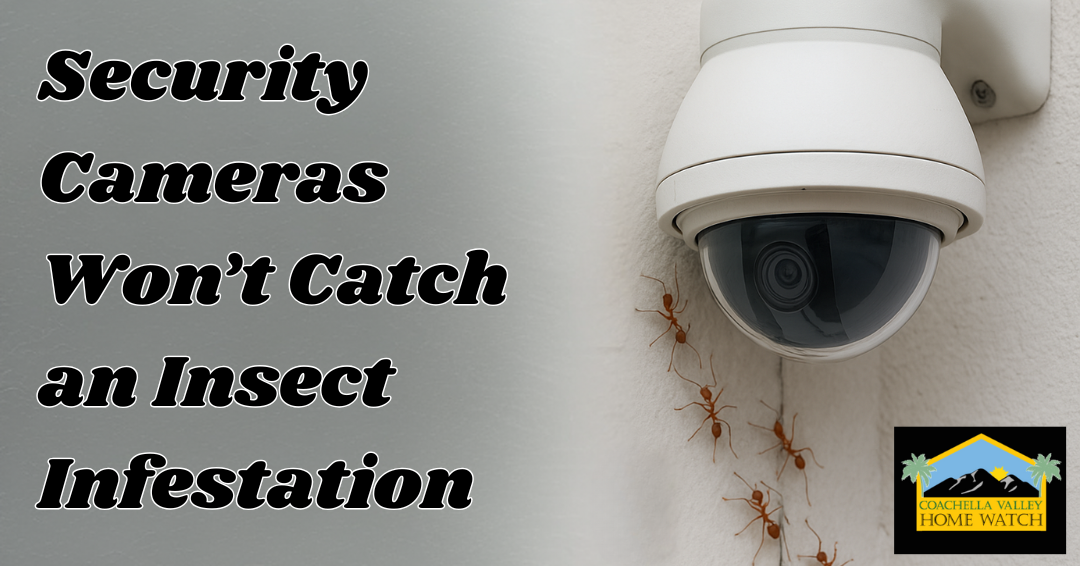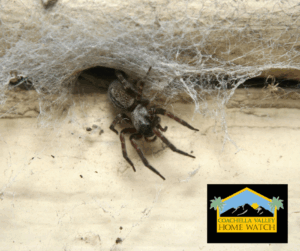
And What Coachella Valley Homeowners Can Do About It
When it comes to protecting your desert home, security cameras provide an invaluable layer of defense, deterring theft, documenting suspicious activity, and even helping with insurance claims. But while these high-tech tools are excellent at spotting humans and large animals, they have a critical blind spot: insect infestation.
Insects don’t trigger motion sensors. They don’t carry flashlights or wear masks. And unless they form a massive swarm directly in front of the lens, most cameras won’t notice a problem until it’s already severe. By the time an infestation is large enough to be picked up visually on a camera, your property may have already sustained significant damage, especially in the harsh, pest-prone climate of the Coachella Valley.
So, how can homeowners and snowbirds protect their investment from silent invaders like termites, ants, cockroaches, or scorpions? It starts by understanding the limits of surveillance—and the value of human oversight.
The Limitations of Security Cameras in Insect Infestation Detection
Security cameras are designed to capture movement and sound from relatively large subjects at a distance, like a person approaching a doorway or a car entering the driveway. But insects operate on an entirely different scale.
1. Size and Speed Work Against Detection
Insects are small, fast, and often nocturnal. Most cameras don’t have the resolution or the focus range to pick up something the size of a termite or ant unless it’s crawling directly on the lens. Even advanced doorbell cameras are designed for macro motion, not micro intrusion.
2. Motion Detection Isn’t Made for Micro-Movements
Standard motion detection software in home surveillance systems is calibrated to pick up activity like footsteps or door movement. These sensors are not triggered by a trail of carpenter ants or a scuttling cockroach. By the time an infestation is visible, it has usually grown to the point where the bugs are swarming or spreading out of the walls, at which point, the problem is serious and costly.
3. Indoor Coverage Gaps Are Common
While exterior cameras are common in vacation homes and second properties, interior cameras are often sparse or absent. Even when installed, they may only cover common areas and entry points—not attics, basements, behind walls, or under sinks, where insect infestations often begin.
Why Insect Infestation Escalates Quickly in the Desert

The Coachella Valley’s hot, dry climate might not seem like a paradise for insects, but it actually creates ideal conditions for certain species. Pest activity spikes with temperature changes, seasonal rains, and human inattention, making unoccupied homes especially vulnerable.
1. Termites Thrive in Desert Conditions
Despite the dry climate, subterranean termites are a major threat in Southern California. These pests build mud tunnels from the ground to your structure and can hollow out wood beams from the inside out, often without being seen until structural damage is evident.
2. Ants, Roaches, and Scorpions Seek Shelter in Empty Homes
With limited food and water in the wild, indoor spaces offer abundant resources for survival. Once inside, insects can nest in walls, under appliances, in attics, or anywhere there’s moisture or warmth.
3. Seasonal Homeowners Are Prime Targets
Empty homes are quiet and undisturbed—perfect for nesting insects. Without regular activity or inspection, a small pest problem can balloon into an expensive emergency by the time the homeowner returns or a camera picks up visual cues.
What Security Cameras Miss That Trained Eyes Catch
This is where human expertise becomes invaluable. A professional home watch provider doesn’t rely on passive surveillance alone. They perform physical walkthroughs, environmental assessments, and visual inspections that are far more sensitive than even the most expensive camera system.
What Coachella Valley Home Watch Professionals Look For:
- Droppings or dead insect trails near windows, baseboards, or entry points.
- Mud tubes or sawdust piles, which often indicate termite activity.
- Moisture accumulation near HVAC systems, under sinks, or in water heater closets—a major attractant for pests.
- Cracks or gaps in weatherstripping, vents, or windows may allow access.
- Unusual smells can signal mold, mildew, or even decaying organic material due to infestation.
Routine in-person checks can identify these issues weeks or even months earlier than cameras or remote monitoring tools.
The Cost of Waiting for Visible Evidence

According to the National Pest Management Association, termites alone cause over $5 billion in property damage each year in the U.S.—and most of that damage is not covered by homeowners’ insurance.
What starts as a few unseen pests can quickly lead to:
- Hollowed wooden support beams
- Ruined drywall and insulation
- Electrical hazards from chewed wiring
- Contamination of food and personal items
- Extensive (and expensive) extermination and repairs
A $200–$300 annual pest prevention plan pales in comparison to the $5,000–$10,000 you could spend mitigating damage from an infestation that security footage didn’t detect.
Prevention Is the Best Investment
Here’s how Coachella Valley Home Watch helps protect your home from more than just intruders:
- Routine In-Person Inspections: Scheduled walkthroughs mean no long gaps between property checks, even when you’re away for the season.
- Moisture and Entry Point Monitoring: We examine plumbing, A/C systems, and common pest entry points to catch early signs of infestation.
- Vendor Coordination: If signs of pests are detected, we can coordinate with licensed pest control providers and supervise treatment.
- Documentation and Reporting: You’ll receive timely, detailed updates, including photo documentation of any suspected pest activity.
We don’t just look for burglars—we safeguard your home from the quiet threats that can do just as much damage.
FAQ: What You Need to Know About Insects and Home Surveillance
Can high-definition security cameras catch early insect infestation?
Not reliably. Even HD or 4K cameras struggle to detect tiny, fast-moving insects unless they are crawling directly in front of the lens. Most infestations begin in hidden, low-traffic areas—like behind walls or under cabinets—where cameras typically aren’t installed. For this reason, early insect activity is almost always missed by surveillance footage.
What are the earliest warning signs of an insect infestation?
Some of the first clues include small piles of sawdust (from termites or carpenter ants), tiny droppings near baseboards (from roaches or rodents), or even subtle rustling sounds inside walls. Other signs include a musty odor or increased spider webs, which may indicate a food source (insects) is already present.
Why is my vacation home more at risk for pests?
Insects are opportunistic. Homes that are unoccupied for long stretches provide a stable, undisturbed environment for nesting. There’s no human traffic, no sudden cleaning or spraying, and often, no ventilation, making it easier for pests to settle in and multiply without detection.
Can I monitor pest activity with smart home devices?
While some smart devices (like environmental sensors for humidity or temperature) can hint at conditions that might encourage pests, there’s no substitute for human observation. Devices may alert you to moisture or temperature changes, but they won’t tell you if something is nesting in your attic unless paired with regular home visits.
What should I do if my camera footage suddenly shows pests?
If you start to see roaches, ants, or other insects on your footage, that usually means the infestation is already well underway. At this point, immediate pest control intervention is necessary. Contact a licensed exterminator, and consider hiring a home watch service to inspect and monitor your home more closely moving forward.
Final Thoughts: Cameras Alone Aren’t Enough
While technology plays an important role in home protection, security cameras simply aren’t equipped to detect the earliest—and most preventable—stages of insect infestation. For homeowners in the Coachella Valley, especially those who spend long periods away, this blind spot can lead to costly consequences.
At Coachella Valley Home Watch, we combine smart security tools with trained eyes on the ground. Our in-person inspections provide the vigilance that cameras can’t offer, catching signs of pests and environmental issues before they become disasters.
Protect your home from the threats you can’t see.
Contact us today to schedule a free consultation and learn more about how our services go beyond the lens. 760-205-2072







No comment yet, add your voice below!